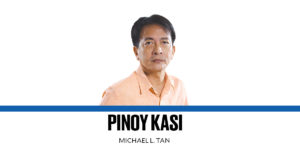What if we gave each of our 42,044 barangays 335 bags of cement each, and let the residents of each of them collectively decide how to use them, while providing the labor themselves? What if one man and one woman are elected in each barangay to lead in planning and implementing projects identified by the community? What if one year later, we reward the barangays that made good use of that cement with another 500 bags of cement, plus steel bars to use with them as reinforcement, again with the same conditions? What if sustained and systematic training is provided to the men and women leaders of all the barangays, to impart the right developmental values, know-how and skills for impelling their communities into collective action for the common good? What if the barangays’ performance is regularly monitored and evaluated so that each of them can find out how they have fared relative to their peers, thereby fostering a friendly competition among them to try and outdo one another in doing good?
These are not hypothetical questions. All of the above were actually done in South Korea’s 33,267 villages starting in 1970, under a nationwide movement called Saemaul Undong (“sae” denotes “new”; “maul” means “village”; and “undong” means “movement”) launched by then President Park Chung-hee. It is credited with the rapid development that South Korea experienced in the decades since then, particularly in narrowing the gap between rural and urban areas in that country.
Just how rapid was that development? In 1965, the Philippines was much richer than South Korea. Our gross domestic product (GDP) per capita (average income per year) was $189, but South Korea’s was only $106. An elderly South Korean colleague once told me that when he first visited the Philippines in the 1960s, he drooled with envy over our facilities and infrastructure, and that Koreans looked up to the Philippines for the level of development we had achieved then. At that time, 80 percent of their rural households reportedly lived under thatched roofs and depended on oil lamps for lighting, as only 20 percent of rural households were electrified then.
But, with the Saemaul Undong, as one account put it: “The villages developed with blinding speed. The rural people regained their confidence. Lethargic neighbors were stimulated to develop their own villages. Korea’s rural areas showed signs of urbanization and development.”
When the movement was launched in 1970, Koreans’ average income was $279, which grew to $403 in 1973, more than doubled to $824 in 1976, and again more than doubled to $1,747 in 1979. By then, our $601 per capita GDP was less than a third of Korea’s. Today, South Korea’s GDP per capita is $32,046, more than 10 times our $3,104. More significantly, while average income of the richest 20 percent (one-fifth) in the Philippines is 8.4 times that of the poorest one-fifth, it is only 5.6 times in Korea. In particular, South Korea’s rural-urban income gap has narrowed; ours has widened.
Ateneo de Manila University visiting fellow Kim Kwan-yong, former three-term governor of Gyeongsangbuk-do and three-term mayor of Gumi City, also known as “Mr. Saemaul,” recently gave a public lecture on Saemaul Undong, and ongoing efforts to globalize it. Critical to its success, he explained, is its combination of top-down and bottom-up impetus. It took the strong drive of South Korea’s presidency to launch and sustain the movement, and allocate resources to provide the 11 million bags of cement that started it all. But equally critical was the collective efforts by the rural residents of Korea in their respective communities.
Can Saemaul Undong work for the Philippines? A student from the audience asked: What if the national government is not as proactive, visionary and willing to put resources in the hands of common people, as the Korean national government had been in launching and sustaining Saemaul Undong? A big IF, indeed.
Governor Kim likened Saemaul Undong to “maejungmul”—Korean for the first bucket of water that is poured into a pump when priming it in order to draw the water from below. It could well be the spark we need to unleash the development potential of the Philippine countryside.
cielito.habito@gmail.com


